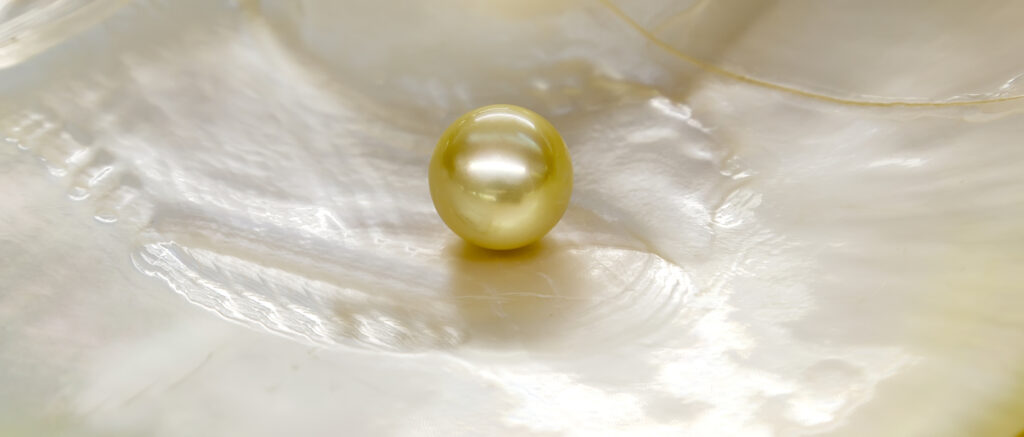Natural, authentic pearls are coveted for their beauty, but do they turn yellow over time?
Over time, real pearls will turn yellow, an almost inevitable result of the aging process. Real pearls will dry out as years go on, and become duller and yellow in color. However, some pearls are naturally yellow or golden, and less susceptible to the results of aging.

Read on to learn more about natural pearls, how they occur, and what happens when they age.
A Miracle Of Nature
In one form or another, pearls have been used by humans for decorative purposes for thousands of years. There is evidence of the Ancient Egyptians using mother-of-pearl, also known as nacre, more than six thousand years ago.
Pearls are composed of this nacre, which is an organic material that’s produced by several species of mollusk. Of course, pearls as we know them typically come from one specific mollusk known as the oyster.
However, it isn’t just oysters that are capable of producing the sought-after and luxurious pearls we see on clothing and jewelry. In truth, there’s a considerable list of mollusks that can ‘manufacture’ pearls, including mussels, clams, and gastropods.
They’re often referred to as a miracle of nature, with the conception of a pearl being entirely natural and remarkable. When an irritant, such as a grain of sand, inadvertently enters the mollusk, the mollusk fights back.
It secretes two substances that are used in the production of its shell, which combine to form nacre, the mother-of-pearl substances we’ve just mentioned. This substance layers itself around the irritant, usually growing bigger, rounder, and smoother over time.
What’s left at the end is a pearl, its composition determined entirely by the way the nacre has arranged itself. It can have a deep shine, a matte surface, and be either white, pink, black, yellow, or golden in color.
While pearls aren’t always round, the misshapen ones still have some value. These days, there are those who attempt to farm pearls by deliberately introducing an irritant into a mollusk’s shell, a long but common process.
It’s actually much more likely that the pearls on your necklace are farmed, as it’s infinitely easier to obtain them this way. It’s incredibly rare to obtain high-grade natural pearls in the wild, and the farming method is much more efficient.
Protecting Your Precious Pearls
As pearls are organic and naturally-occurring, they’re much more susceptible to damage and degradation over time. It’s an unfortunate fact, but you’ll have to go to considerable lengths to protect your pearls.
This includes taking steps to clean your pearls with a soft cloth after every single wear, otherwise, the oils from your skin could damage them. You should have them examined by a jeweler once a year, who will determine the integrity of your pearls and clean them if needed.
When you’re storing a pearl necklace or bracelet, it should be kept well away from contaminants like perfume or hairspray. It should be kept flat, in a dedicated location, and worn often to ensure the pearls don’t ‘dry out’.
Don’t forget, pearls are manufactured in an ocean environment, and they’ll fare best in a moist atmosphere. If they’re allowed to dry out, they can peel or weaken, and they’ll lose value.
Over time, this dryness can turn a natural white pearl yellow, especially if it has been left to age for several years. If enough time has passed, the discoloration process is irreversible, and the pearls may eventually crack or shatter.
However, as we’ve mentioned, some pearls are naturally yellow or golden, having been cultivated in a slightly different way inside the mollusk. They’re a little rarer than the standard white pearl, and as such, are a little higher priced.
The Ultimate Pearl
There are several factors taken into consideration with the valuation of a pearl. The type, size, color, shape, luster, and overall quality of a pearl all weigh in quite heavily where the value is concerned.
The most valuable pearl in history was an enormous creation with a weight of seventy-five pounds. It was discovered in the Philippines by a fisherman who allegedly kept it under his bed for years, as a good luck charm.
It’s reportedly worth around one hundred million dollars, making it the most expensive pearl in history. However, it wasn’t a perfectly round pearl, but a misshapen and bizarre-looking pile of nacre.
Although, as we’ve stated, it isn’t just the perfectly round pearls that boast a considerable value.
